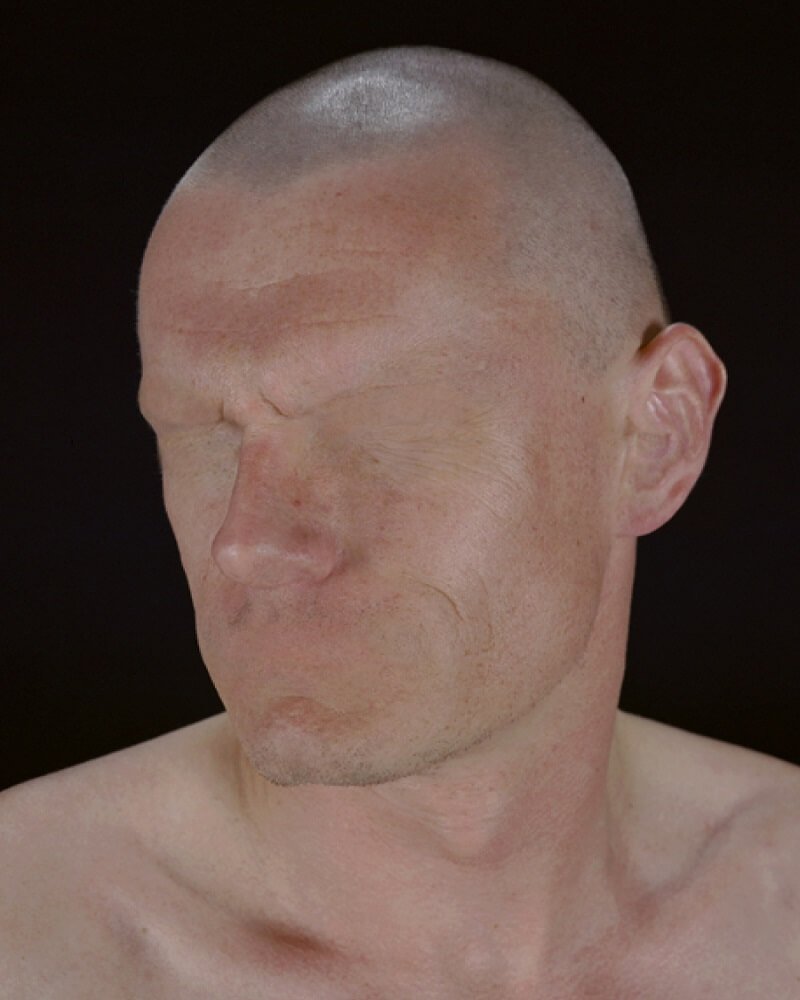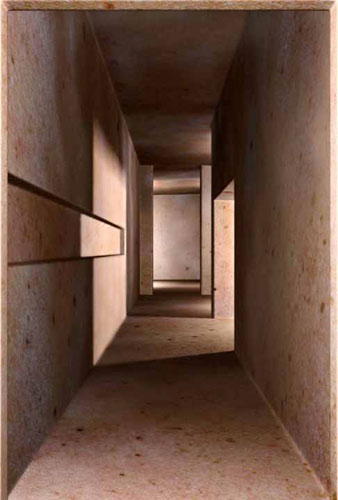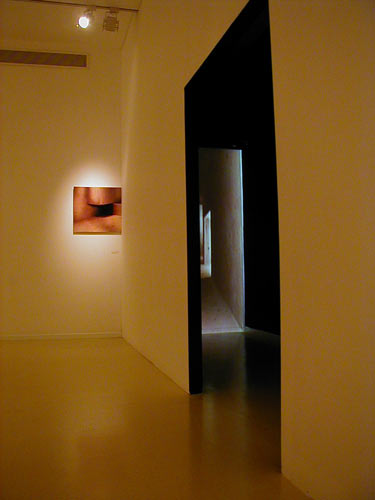Maria, 1994, from Dystopia series
Aziz + Cucher: Passage
The Herzliya Museum of Art, Israel
May 2002
Located at the end of the hallway leading into the show, the new animated piece Passage is the metaphorical threshold through which one can enter into the depths of Aziz + Cucher’s oeuvre. A long and narrow corridor delineated by breathing walls creates an illusion of spatial depth, expanding the museum’s physical space. The end of the corridor is blocked; the light emanating therefrom attests to yet another corridor. Operating behind these fleshy walls is a mysterious power, a nerve system, perhaps even a brain too. Aziz + Cucher lend a new poetic meaning to the notions ‘breathing space’ or ‘living space’.
Departing from this threshold I would like to delve into earlier series of digitally manipulated photographic works by Aziz + Cucher, selections from which are featured in the current show: two de-faced portraits from the series Dystopia (1995), six biomorphic creatures from the series Chimera (1998-1999), and seven photographs of architectural spaces from the seriesInteriors (1998-2000).
Aziz + Cucher’s consistent and continuous preoccupation with post-human situations and the meeting points between the social, biological and technological, reach conceptual refinement in this show. The implications of bio-technology on the very definition of the human condition, the impact of man-machine / man-computer interrelations on the constitution of human identity in the third millennium, the AIDS epidemic, and the exposure of the metaphorical pathologies that are the price of progress – all these are articulated in images that present a body without actually representing it. It is a body without a heart, devoid of contour, faceless, a body that seems to have been entirely compressed into the margins of the envelope containing it – into the epidermis protecting it.
The philosophical idea that the external topography of the skin reflects the mysteries of the human organism, mirroring the body’s interior as a map, or an index, is not a new one. From the early days of medicine, the skin was ascribed ‘communicative’ qualities as a diagnostic tool, a text that unfolds the body’s ailments. It was assumed that anything appearing on the surface of the skin is symptomatic of an inner occurrence. In the post-modern discourse, the skin has become the symbolic calling card of identity. Aziz + Cucher take this idea to the poetic (and paradoxical) limit, supplementing these qualities with the metaphorical power of the skin as a vulnerable and sensitive, telling and protective organ that defines the boundaries of the human body, underlying the dialectics of inner and outer.
In Chris and Maria – two works from the seriesDystopia – the skin discloses nothing. The interaction with the outside has been blocked, and nothing attests to any inner occurrence. This is Aziz + Cucher’s dystopian version of the traditional portrait photography genre: monumental portraits of people (Chris and Maria?!) dispossessed of their identity and shut off from the world. The sensorial organs – the eyes, the mouth, the nostrils and the ear orifices – were blocked by means of a delicate skin graft, and thus the facial features, the very heart and soul of portrait photography, the necessary physiognomy for conveying the authentic photographic truth, were completely erased. Deaf, dumb and blind, these creatures appear trapped within the envelope of their skin, confined within the external crust of their being, unable to breathe, smell, listen or taste.
As in Jose Saramago’s novel Blindness, Aziz + Cucher take allegory to its absurd limit. From a face devoid of identity and expression they shift to body-less organs. In the series Chimera (six pieces of which are presented here) they offer us a new zoological mutation – unidentified biomorphic objects that call to mind computer peripherals or advanced medical equipment, wrapped with human skin, with all its bristles, pimples, moles and pores. According to the dictionary, a ‘chimera’ is a mythological fire-breathing monster, commonly represented with a lion’s head, a goat’s body, and a serpent’s tail. Due to its hybridic nature, it has become synonymous with cross-breeds. In genetics, a chimera denotes an organism that is partly male partly female; a creature artificially composed of two or more genetically distinct tissues.
Chimera is also a flight of the imagination, a delusion. Indeed, Aziz + Cucher introduce a ’still life’ gone wild, a cross between ‘still’ and ‘life’ in a new evolutionary state of aggregation: vertical cyborgs hover in a black space, outside of time, like threatening extensions of the human body subsequent to its full fusion with technology in a failed genetic experiment. The twisted, crushed, curved, sculptural – albeit so very human – forms reminded me of the curiosity collections that populated the first ‘museums’. These are digital totems, the new fetishes of the 21st century, a cybernetic Still Life of sorts, which like the skull, extinguished candle and mirror from the tradition of Vanitas painting, remind us that even if we put all our trust in technology, life will still remain transient.
In the series of architectural Interiors, a substantial part of which is presented here, the body disappears entirely. It is as though the ‘self’ has been drained of its internality and merged with the space within which it exists. The surreal element has been exaggerated. The partition between object and subject, ‘exterior’ and ‘interior’ has collapsed, and all that remains of the body is the epidermal layer that has now transformed into an architectural envelope delineating empty, exposed, minimalist modernist spaces. A greater ‘crime’ than this in terms of the ideology of modernist architecture seems unthinkable: the functional and anonymous strict geometrical lines of the building have grown delicate, blurred, too human/feminine, ‘adorned’ with the entire spectrum of potential superficial blemishes: pimples, pores, beauty spots and freckles.
The relationship between ‘exterior’ and ‘interior’ in these works highlights the enigmatism typifying their work: if we were to imagine ourselves inside these rooms – would we still be looking at them from the outside? Is it at all accurate to dub them interior photographs? In any event, it seems that the viewer is always standing on the threshold. The eye wandering across the surface roams between the rooms and corridors, going up and down the staircases, as in a nightmarish journey into the realms of the unconscious.
Even though these are not specific ‘places’, the anonymity of the empty halls, corridors and rooms calls to mind institutional architecture (one of the works is indeed based on a photograph of a real building: a holiday resort with 10,000 identical rooms built in 1941 for members of the Third Reich by the Baltic Sea.) However, to a greater extent, these rooms conjure up the digital halls and mazes of computer games. They may also be read as an ironic rendering of the concept ‘organic architecture’, a current trend that strives to create a similitude between bodily and architectural interfaces.
This is certainly not the organicity to which Fredric Jameson alluded in his discussion of post-modern architecture. Jameson talked about a ‘new kind of superficiality’ expressing the mutation effected by the media in the representation of death (via photography); he referred to the neutralization of organicity, to a cold, sterilizing, mechanical treatment. In Passage, an animated work that seems to epitomize ‘organicity’, Aziz + Cucher take the superficial stance foretold by Jameson to its paradoxical limit: through digital staging of the surface, the body depicted with uncanny realism that spares the viewer none of the most abject skin blemishes and freckles, undergoes such a radical transformation that it becomes a virtual fiction. The ‘organicity’ has transformed into a body-less independent entity that runs wild behind the walls, threatening to break through the barrier of the skin, and tear apart the protective partition between ’inside’ and ‘outside’.
Translation: Daria Kassovsky
Aziz + Cucher: Passage
Herzliya Museum of Contemporary Art
June - August 2002
The first solo exhibition of Aziz + Cucher in Israel. Their work explore the range of technology’s presence and imposition in our lives. Passage focused on selections from three bodies of work produced by the artists since 1995: Dystopia, Interiors and the Chimera series, as well as a premier presentation of their first digital animation Passage. In each of these series Aziz + Cucher tackled issues of identity and the post-modern self, by digitally manipulating photographic prints and three-dimensional architecture.
Aziz + Cucher: Passage
The Herzliya Museum of Art, Israel
May 2002
Located at the end of the hallway leading into the show, the new animated piece Passage is the metaphorical threshold through which one can enter into the depths of Aziz + Cucher’s oeuvre. A long and narrow corridor delineated by breathing walls creates an illusion of spatial depth, expanding the museum’s physical space. The end of the corridor is blocked; the light emanating therefrom attests to yet another corridor. Operating behind these fleshy walls is a mysterious power, a nerve system, perhaps even a brain too. Aziz + Cucher lend a new poetic meaning to the notions ‘breathing space’ or ‘living space’.
Departing from this threshold I would like to delve into earlier series of digitally manipulated photographic works by Aziz + Cucher, selections from which are featured in the current show: two de-faced portraits from the series Dystopia (1995), six biomorphic creatures from the series Chimera (1998-1999), and seven photographs of architectural spaces from the seriesInteriors (1998-2000).
Aziz + Cucher’s consistent and continuous preoccupation with post-human situations and the meeting points between the social, biological and technological, reach conceptual refinement in this show. The implications of bio-technology on the very definition of the human condition, the impact of man-machine / man-computer interrelations on the constitution of human identity in the third millennium, the AIDS epidemic, and the exposure of the metaphorical pathologies that are the price of progress – all these are articulated in images that present a body without actually representing it. It is a body without a heart, devoid of contour, faceless, a body that seems to have been entirely compressed into the margins of the envelope containing it – into the epidermis protecting it.
The philosophical idea that the external topography of the skin reflects the mysteries of the human organism, mirroring the body’s interior as a map, or an index, is not a new one. From the early days of medicine, the skin was ascribed ‘communicative’ qualities as a diagnostic tool, a text that unfolds the body’s ailments. It was assumed that anything appearing on the surface of the skin is symptomatic of an inner occurrence. In the post-modern discourse, the skin has become the symbolic calling card of identity. Aziz + Cucher take this idea to the poetic (and paradoxical) limit, supplementing these qualities with the metaphorical power of the skin as a vulnerable and sensitive, telling and protective organ that defines the boundaries of the human body, underlying the dialectics of inner and outer.
In Chris and Maria – two works from the seriesDystopia – the skin discloses nothing. The interaction with the outside has been blocked, and nothing attests to any inner occurrence. This is Aziz + Cucher’s dystopian version of the traditional portrait photography genre: monumental portraits of people (Chris and Maria?!) dispossessed of their identity and shut off from the world. The sensorial organs – the eyes, the mouth, the nostrils and the ear orifices – were blocked by means of a delicate skin graft, and thus the facial features, the very heart and soul of portrait photography, the necessary physiognomy for conveying the authentic photographic truth, were completely erased. Deaf, dumb and blind, these creatures appear trapped within the envelope of their skin, confined within the external crust of their being, unable to breathe, smell, listen or taste.
As in Jose Saramago’s novel Blindness, Aziz + Cucher take allegory to its absurd limit. From a face devoid of identity and expression they shift to body-less organs. In the series Chimera (six pieces of which are presented here) they offer us a new zoological mutation – unidentified biomorphic objects that call to mind computer peripherals or advanced medical equipment, wrapped with human skin, with all its bristles, pimples, moles and pores. According to the dictionary, a ‘chimera’ is a mythological fire-breathing monster, commonly represented with a lion’s head, a goat’s body, and a serpent’s tail. Due to its hybridic nature, it has become synonymous with cross-breeds. In genetics, a chimera denotes an organism that is partly male partly female; a creature artificially composed of two or more genetically distinct tissues.
Chimera is also a flight of the imagination, a delusion. Indeed, Aziz + Cucher introduce a ’still life’ gone wild, a cross between ‘still’ and ‘life’ in a new evolutionary state of aggregation: vertical cyborgs hover in a black space, outside of time, like threatening extensions of the human body subsequent to its full fusion with technology in a failed genetic experiment. The twisted, crushed, curved, sculptural – albeit so very human – forms reminded me of the curiosity collections that populated the first ‘museums’. These are digital totems, the new fetishes of the 21st century, a cybernetic Still Life of sorts, which like the skull, extinguished candle and mirror from the tradition of Vanitas painting, remind us that even if we put all our trust in technology, life will still remain transient.
In the series of architectural Interiors, a substantial part of which is presented here, the body disappears entirely. It is as though the ‘self’ has been drained of its internality and merged with the space within which it exists. The surreal element has been exaggerated. The partition between object and subject, ‘exterior’ and ‘interior’ has collapsed, and all that remains of the body is the epidermal layer that has now transformed into an architectural envelope delineating empty, exposed, minimalist modernist spaces. A greater ‘crime’ than this in terms of the ideology of modernist architecture seems unthinkable: the functional and anonymous strict geometrical lines of the building have grown delicate, blurred, too human/feminine, ‘adorned’ with the entire spectrum of potential superficial blemishes: pimples, pores, beauty spots and freckles.
The relationship between ‘exterior’ and ‘interior’ in these works highlights the enigmatism typifying their work: if we were to imagine ourselves inside these rooms – would we still be looking at them from the outside? Is it at all accurate to dub them interior photographs? In any event, it seems that the viewer is always standing on the threshold. The eye wandering across the surface roams between the rooms and corridors, going up and down the staircases, as in a nightmarish journey into the realms of the unconscious.
Even though these are not specific ‘places’, the anonymity of the empty halls, corridors and rooms calls to mind institutional architecture (one of the works is indeed based on a photograph of a real building: a holiday resort with 10,000 identical rooms built in 1941 for members of the Third Reich by the Baltic Sea.) However, to a greater extent, these rooms conjure up the digital halls and mazes of computer games. They may also be read as an ironic rendering of the concept ‘organic architecture’, a current trend that strives to create a similitude between bodily and architectural interfaces.
This is certainly not the organicity to which Fredric Jameson alluded in his discussion of post-modern architecture. Jameson talked about a ‘new kind of superficiality’ expressing the mutation effected by the media in the representation of death (via photography); he referred to the neutralization of organicity, to a cold, sterilizing, mechanical treatment. In Passage, an animated work that seems to epitomize ‘organicity’, Aziz + Cucher take the superficial stance foretold by Jameson to its paradoxical limit: through digital staging of the surface, the body depicted with uncanny realism that spares the viewer none of the most abject skin blemishes and freckles, undergoes such a radical transformation that it becomes a virtual fiction. The ‘organicity’ has transformed into a body-less independent entity that runs wild behind the walls, threatening to break through the barrier of the skin, and tear apart the protective partition between ’inside’ and ‘outside’.
Translation: Daria Kassovsky
Aziz + Cucher: Passage
Herzliya Museum of Contemporary Art
June - August 2002
The first solo exhibition of Aziz + Cucher in Israel. Their work explore the range of technology’s presence and imposition in our lives. Passage focused on selections from three bodies of work produced by the artists since 1995: Dystopia, Interiors and the Chimera series, as well as a premier presentation of their first digital animation Passage. In each of these series Aziz + Cucher tackled issues of identity and the post-modern self, by digitally manipulating photographic prints and three-dimensional architecture.
Maria, 1994, from Dystopia series




















